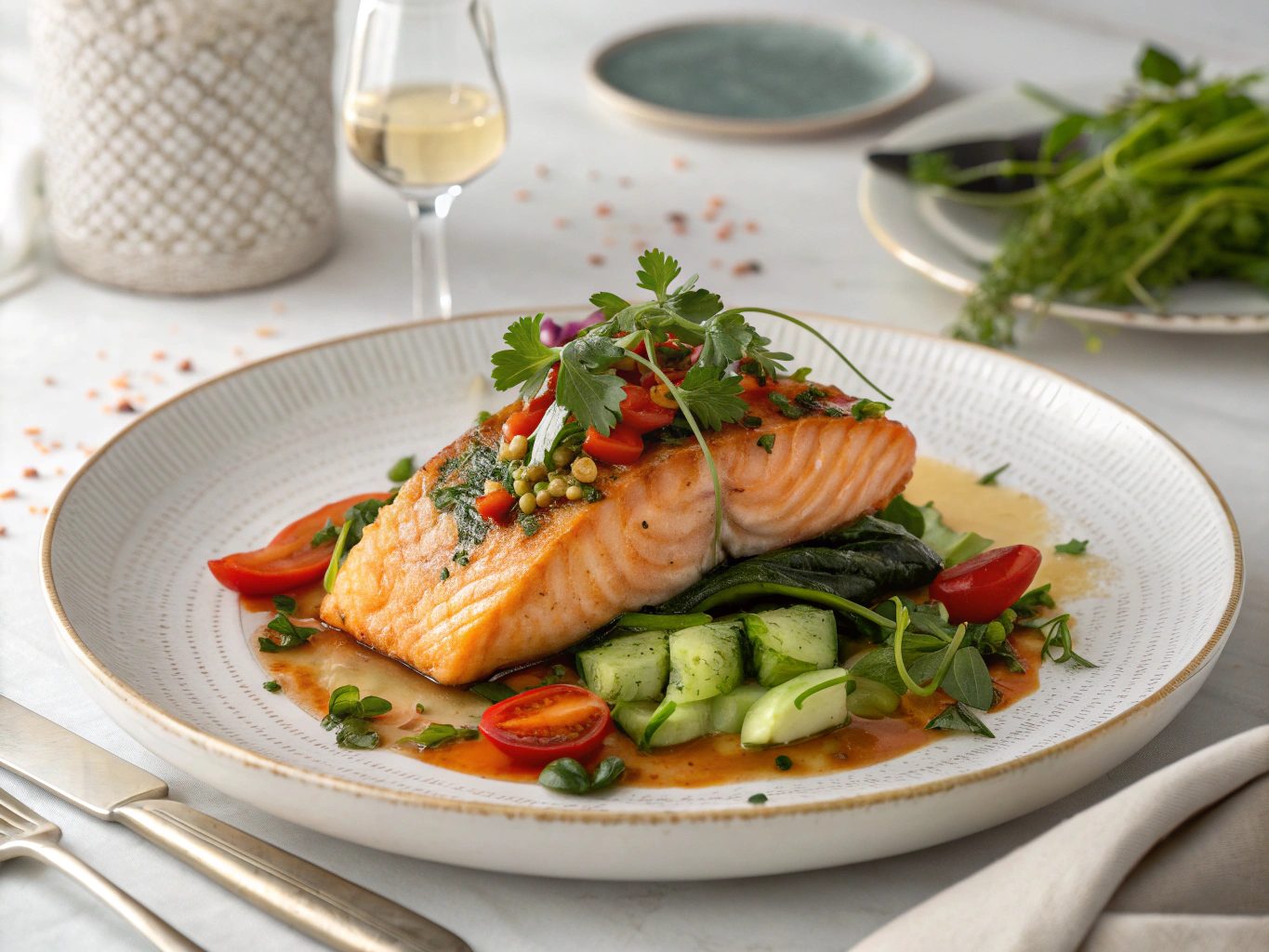
If you love bold umami flavors and quick weeknight dinners, you’re in for a treat. In this post, we’ll dive into a flavorful miso salmon recipe that brings together savory miso paste, heartwarming memories, and simple kitchen techniques. You’ll learn how to marinate, cook, and serve miso salmon with just a few pantry staples, and we’ll tackle common questions like “Is miso good on salmon?” or “How long should I marinate salmon in miso?” Whether you’re new to fish or a confident home cook, this easy and comforting recipe will guide you step-by-step—ending on a perfectly caramelized, melt-in-your-mouth finish.
A Charleston Memory Meets Japanese Comfort
Cooking with Grandma, Evolving with Curiosity
Growing up in Charleston, my first unforgettable kitchen memory was at Grandma’s old stove. Oil sizzling, spices humming in the air, the evening sun hopping across her apron. She didn’t measure ingredients—she just knew. When I began experimenting as an adult, it was her voice I heard when folding funky miso paste into classic dishes, like glazed salmon. So, when someone asked me years later, “Does miso paste go with fish?” my answer was a loud, soulful “Absolutely.”
Miso salmon has since become a recurring hero in my kitchen. It’s the kind of dish that takes basic salmon, infuses it with rich depth, and gives it a sea-sweet umami that’s both exotic and familiar. This recipe was born out of love for contrasts: silky fish and bold paste, savory tones brightened with sugar and rice vinegar, firm crust giving way to buttery flesh.
When Bold Meets Honest Simplicity
The best part? Miso salmon is surprisingly easy, requiring no fancy skills. The marinade comes together so fast, and once it hits a hot broiler, you get caramelized edges and tender flakes in under 15 minutes.
From weeknight pan-searing to broiling for a dinner party spread, this dish adapts—and impresses. It also pairs incredibly well with sides like roasted miso Brussels sprouts like the ones I explored in this roasted vegetable breakdown. I even once served it over leftover rice and added a soft egg for a knockout breakfast bowl. Playful, flexible food—that’s how we grow as cooks.
And if you’re already in the mood for flavor-loaded fish, you’ll also enjoy the marinade secrets from my honey garlic tofu steaks. These adaptable glazes and cooking methods could make your fridge leftovers into your next showstopper.
How to Make Miso Salmon from Scratch
Ingredients That Build Umami Layers
You don’t need to visit a specialty market to make good miso salmon. Here’s what you’ll need:
- 4 salmon fillets, skin on or off
- 2 tbsp white miso paste (or yellow—don’t use red for this)
- 1 tbsp mirin (or substitute white wine)
- 2 tsp soy sauce or tamari for gluten-free
- 1 tbsp brown sugar or honey
- 2 tsp rice vinegar
- Optional: 1 tsp grated fresh ginger or garlic
- Optional toppings: sesame seeds, sliced green onions, lime wedges
Substitution notes: No miso? Try tahini with a splash of soy sauce, though flavor won’t be exact. Salmon can be swapped for steelhead trout for similar texture, and vegetarians can use thick-sliced tofu.
This marinade also complements a more complete plate. For example, layering miso-flavored proteins over pumpkin rice stuffing adds a cozy autumn vibe that’s hard to beat.
Timing Breakdown: Quick, Yet Big on Flavor
| Step | Time |
|---|---|
| Marinating salmon | 30 minutes to overnight |
| Prep & mix marinade | 5 minutes |
| Cook time (broil or bake) | 10–12 minutes |
| Total time (excluding marinate) | 15–20 minutes |
Step-by-Step Miso Salmon Cooking Guide
- In a bowl, whisk together miso paste, soy sauce, mirin, brown sugar, vinegar, and ginger.
- Dab the salmon fillets dry. Spread marinade on all sides, especially the top. Place in glass or ceramic dish.
- Marinate uncovered in the fridge for 30 minutes, or covered up to 24 hours for deeper flavor.
- Preheat oven to broil setting or 425°F if baking.
- Line a sheet with foil and lightly oil. Lay salmon skin-side down (if it has skin).
- Broil 6 inches from heat for 6–9 minutes until caramelized and flaky. Bake for 12 minutes if using oven.
- Serve hot with garnish—maybe a warm bowl of coconut mushroom wild rice on the side.
Fun fact: Miso brings probiotics and heart-friendly benefits as backed by the Harvard T.H. Chan School of Public Health, making deliciousness smart, too.
Exploring Why Miso Works So Well with Salmon
The Science of the Flavor Match
So, why is miso good on salmon? It all comes down to umami. Salmon is already rich in natural glutamate, and miso paste—especially white or yellow—adds fermented complexity without overwhelming the fish’s natural flavor. The sugars in the paste caramelize under heat, introducing savory depth and a slightly sweet crunch.
This winning combination is similar to the glaze used in dishes like bbq jackfruit enchiladas, where sweetness balances spice. With miso salmon, the soy elements anchor the glaze firmly in salty richness.
Choosing Between Red, White, and Yellow Miso
Each miso type brings a different intensity. For salmon, white miso (Shiro) is most flexible—it’s smooth, mildly sweet, and suits short marinades. Yellow miso (Shinshu) is deeper and earthier but still works well. Red miso (Aka) should be reserved for hearty stews or longer braises, as its bite can overpower fish.
Not sure your local store has miso? Try finding it in the refrigerated tofu area. Or tap your miso knowledge into sweet additions like miso-maple sesame dressings or funky compound butters for vegetables. Just like with miso mushroom gravy, once you start exploring, the paste becomes one of your best pantry partners.
Next-Level Tips for Serving and Pairing Miso Salmon
Serving Variations You’ll Love
Miso salmon adapts to any mood—make sushi rice bowls, miso salmon tacos, or slide it over a spring salad. One of my favorite renditions includes a chilled miso-glazed salmon flaked over soba noodles.
Or try a Southern-Japanese mix-up by serving it with roasted okra and creamy polenta. The creamy base tempers the umami and makes each bite luxurious.
Pair with bold veggies like charred cabbage or a cucumber-radish salad with rice vinegar.
Storing, Reheating & Meal Prep
Got leftovers? Store cooked salmon in airtight glass containers for up to 3 days. Reheat under low heat or flake into a rice bowl. The miso flavor strengthens slightly with time, similar to how stews deepen by the next day.
Raw marinated fish should be cooked within 24 hours. Don’t freeze uncooked miso-marinated salmon unless vacuum-sealed, as standard wrapping might dilute the marinade.
Meal prep tip: Make a double batch of marinade. Use half on salmon and toss the rest onto roasted eggplant, sweet potatoes, or even tofu overnight. The result is a medley of flavor-packed, ready-to-go components. Perfect for a week of satisfying meals.
FAQ
Is miso good on salmon?
Yes, miso is fantastic on salmon. Its umami richness complements the natural oils in salmon, while the sweetness helps create a delicious glaze during cooking.
How long should I marinate salmon in miso?
For ideal depth, marinate for 30 minutes to 2 hours. Overnight yields boldest flavor, though 30 minutes works well for weeknights.
Does miso paste go with fish?
Absolutely. Especially white or yellow miso, which work well with delicate proteins like fish and shellfish for a flavorful but balanced taste.
What is oshi salmon made of?
Oshi salmon (or oshizushi salmon) is a pressed sushi made with vinegared rice and cured or seared salmon, sometimes brushed with miso or soy-based glazes.
Conclusion
Miso salmon is more than a trendy dish—it’s a memory carrier, an umami bomb, and a quick path to impressing yourself or your guests. It’s adaptable, deeply flavorful, and approachable for any skill level. Whether you marinate it for 30 minutes or overnight, the results are always savory and satisfying. I hope this recipe inspires your curiosity and lends joy to your dinner table. Keep experimenting, keep tasting, and don’t sweat the smoke alarms—they’re just part of the journey.
